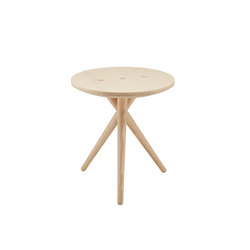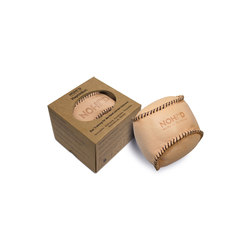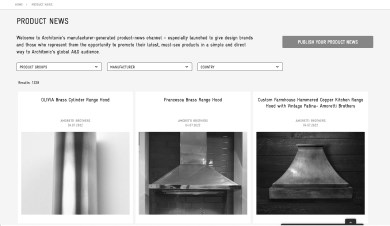Sobre Karen Chekerdjian
DESCUBRE MáS SOBRE KAREN CHEKERDJIAN
After graduation, Karen worked in Milan for a number of years. During this period, one of her first designs – a suspended hanger system entitled Mobil – was produced by EDRA.
In 2001, she returned to Beirut and opened Karen Chekerdjian Studio. Beginning as more of a conceptual think-tank, dedicated to exploring new ideas in design, the Studio has gradually become more focussed on production; furniture and everyday objects in small series, limited editions and made-to-order commissions. The Studio also takes on interior design projects, which have included restaurants, a hotel, retail stores and most recently, Maison Rabih Kayrouz, the flagship Beirut boutique of the Lebanese couturier.
Karen Chekerdjian Store opened in 2010 in the up-and-coming Beirut Port neighbourhood. The Store showcases Karen's work and also stocks a thoughtful selection of items produced by other people ranging from design objects to specialty food items. Karen's work is displayed at a number of boutiques around Beirut and Milan, chief amongst them contemporary Middle Eastern handicrafts boutique Orient 499, the city's premier vintage furniture stockists XXe Siècle, and the famous Nilufar Gallery on Via della Spiga.
Karen regularly participates in some of the biggest annual design fairs, including New York's ICFF, Milan's Salone del Mobile, Cologne's Mobelmesse and Paris' Furniture Fair. Her work has also been displayed at a number of international exhibitions, amongst them Utopi (Copenhagen), Beyond the Myth (a pan-European show), Promosedia 2007 (Milan), Northern Lights (Tokyo) and ECHO (Beirut) and at galleries ranging from The Issey Miyake Foundation (Tokyo) and Spazio Orlandi Gallery and Nilufar Gallery (Milan) and Sfeir-Semler Gallery (Beirut).
Design Approach
Upon returning to Lebanon from Italy, Karen was faced with a number of challenges, chiefly in terms of the availability of materials and manufacturing techniques. She soon realized she would have to re-think the way she operated. Her focus, previously more on the concept behind her objects than on the way they were made, began to shift. With only a limited tradition of product manufacturing to draw upon, Lebanon was not a country in which prototypes or the sketches of ideas could simply be dispatched to the factory. Rather than dwell on the downside, Karen researched new ways of creating. If advanced technical materials were not easily available, she would create with materials that were, such as wood, ceramics, metal and glass. If the factories were not equipped with modern machinery, perhaps the solution lay elsewhere. She knew that Lebanon possessed a cadre of highly skilled if increasingly unused traditional craftspeople – amongst them carvers, brass makers, embroiderers and glass-blowers – and so began to explore the possibility of getting her work made by hand, on an individual basis, rather than mass-produced by machine. By necessity, production became a more hands-on affair. Karen's process of creation is collaborative. Although she has a clear idea of what she wants, she allows the craftspeople she works with the opportunity to leave their own mark on her products, giving them the latitude, for example, to make their own variations on the patterns that decorate her pieces. It is also, at times, combative. Karen's vision, that of a contemporary industrial designer, is frequently in direct opposition to the traditional, crafts-oriented outlook of her collaborators. Unwilling to take 'no' for an answer and through a process of trial and error, consultation and revision, her catalogue continues to grow. Karen's work falls into a category of its own, one that could be called 'Industrial Handicrafts'. Unmoored from time thanks to their blend of traditional manufacturing technique and industrial aesthetic, distinctively Lebanese and yet also International, these objects are comfortable in almost any kind of space, as much at home in a traditional Levantine house as they would be in a minimalist interior. As such, they are perfect reflections of the spirit of the city in which they are created.
After graduation, Karen worked in Milan for a number of years. During this period, one of her first designs – a suspended hanger system entitled Mobil – was produced by EDRA.
In 2001, she returned to Beirut and opened Karen Chekerdjian Studio. Beginning as more of a conceptual think-tank, dedicated to exploring new ideas in design, the Studio has gradually become more focussed on production; furniture and everyday objects in small series, limited editions and made-to-order commissions. The Studio also takes on interior design projects, which have included restaurants, a hotel, retail stores and most recently, Maison Rabih Kayrouz, the flagship Beirut boutique of the Lebanese couturier.
Karen Chekerdjian Store opened in 2010 in the up-and-coming Beirut Port neighbourhood. The Store showcases Karen's work and also stocks a thoughtful selection of items produced by other people ranging from design objects to specialty food items. Karen's work is displayed at a number of boutiques around Beirut and Milan, chief amongst them contemporary Middle Eastern handicrafts boutique Orient 499, the city's premier vintage furniture stockists XXe Siècle, and the famous Nilufar Gallery on Via della Spiga.
Karen regularly participates in some of the biggest annual design fairs, including New York's ICFF, Milan's Salone del Mobile, Cologne's Mobelmesse and Paris' Furniture Fair. Her work has also been displayed at a number of international exhibitions, amongst them Utopi (Copenhagen), Beyond the Myth (a pan-European show), Promosedia 2007 (Milan), Northern Lights (Tokyo) and ECHO (Beirut) and at galleries ranging from The Issey Miyake Foundation (Tokyo) and Spazio Orlandi Gallery and Nilufar Gallery (Milan) and Sfeir-Semler Gallery (Beirut).
Design Approach
Upon returning to Lebanon from Italy, Karen was faced with a number of challenges, chiefly in terms of the availability of materials and manufacturing techniques. She soon realized she would have to re-think the way she operated. Her focus, previously more on the concept behind her objects than on the way they were made, began to shift. With only a limited tradition of product manufacturing to draw upon, Lebanon was not a country in which prototypes or the sketches of ideas could simply be dispatched to the factory. Rather than dwell on the downside, Karen researched new ways of creating. If advanced technical materials were not easily available, she would create with materials that were, such as wood, ceramics, metal and glass. If the factories were not equipped with modern machinery, perhaps the solution lay elsewhere. She knew that Lebanon possessed a cadre of highly skilled if increasingly unused traditional craftspeople – amongst them carvers, brass makers, embroiderers and glass-blowers – and so began to explore the possibility of getting her work made by hand, on an individual basis, rather than mass-produced by machine. By necessity, production became a more hands-on affair. Karen's process of creation is collaborative. Although she has a clear idea of what she wants, she allows the craftspeople she works with the opportunity to leave their own mark on her products, giving them the latitude, for example, to make their own variations on the patterns that decorate her pieces. It is also, at times, combative. Karen's vision, that of a contemporary industrial designer, is frequently in direct opposition to the traditional, crafts-oriented outlook of her collaborators. Unwilling to take 'no' for an answer and through a process of trial and error, consultation and revision, her catalogue continues to grow. Karen's work falls into a category of its own, one that could be called 'Industrial Handicrafts'. Unmoored from time thanks to their blend of traditional manufacturing technique and industrial aesthetic, distinctively Lebanese and yet also International, these objects are comfortable in almost any kind of space, as much at home in a traditional Levantine house as they would be in a minimalist interior. As such, they are perfect reflections of the spirit of the city in which they are created.
DESCUBRE MáS SOBRE KAREN CHEKERDJIAN



















